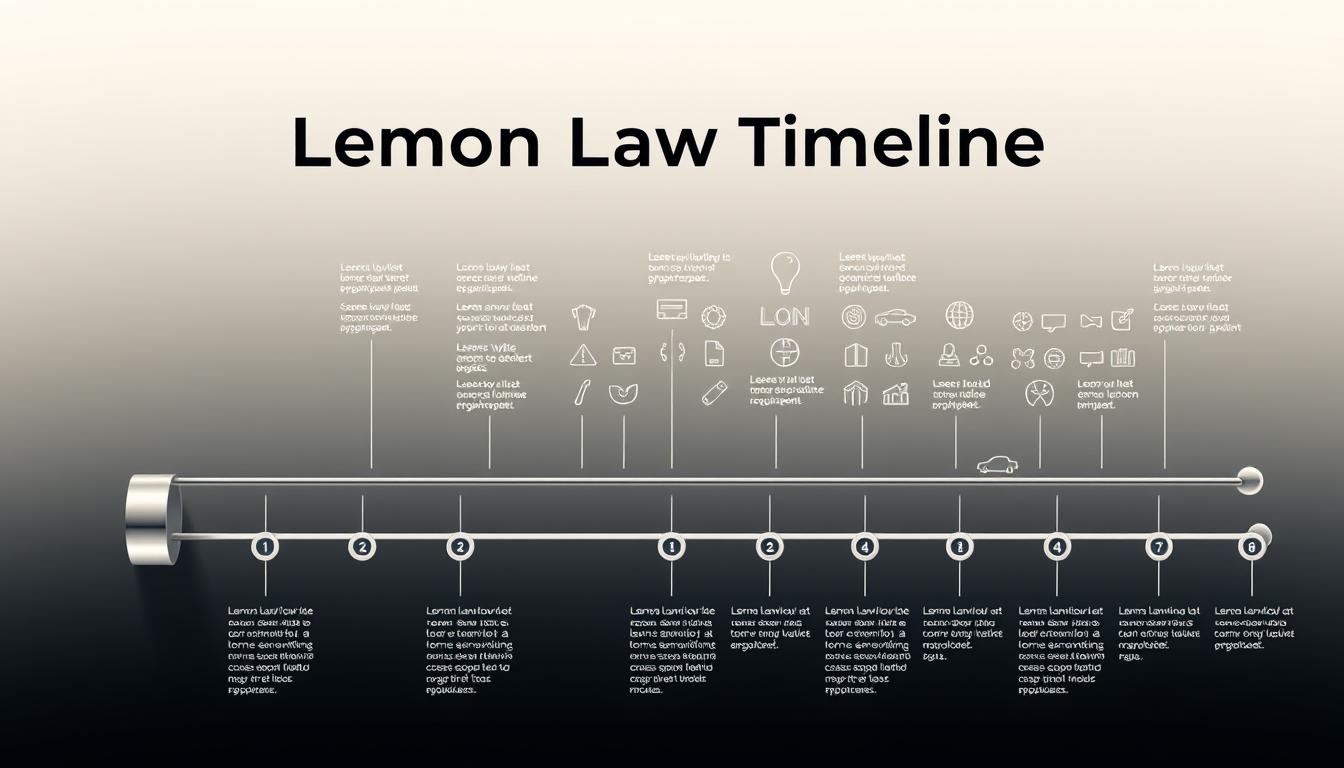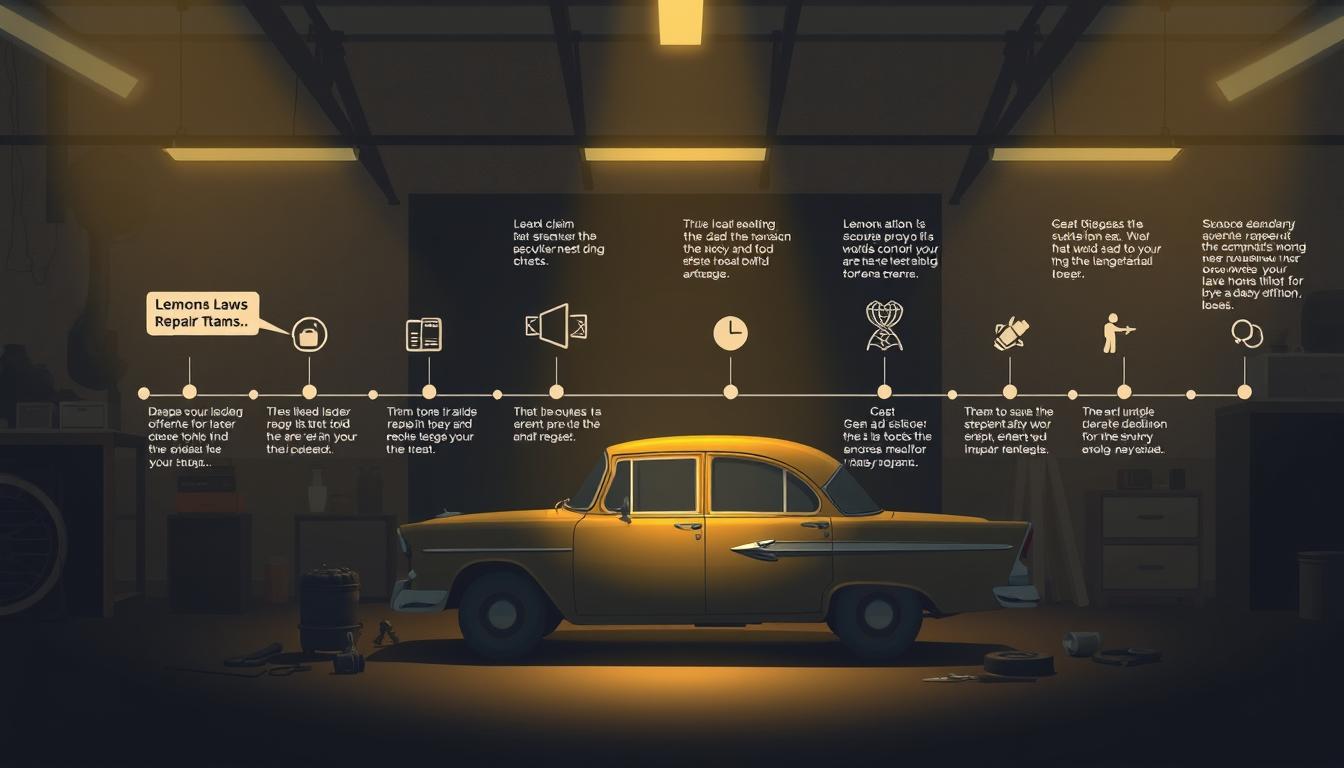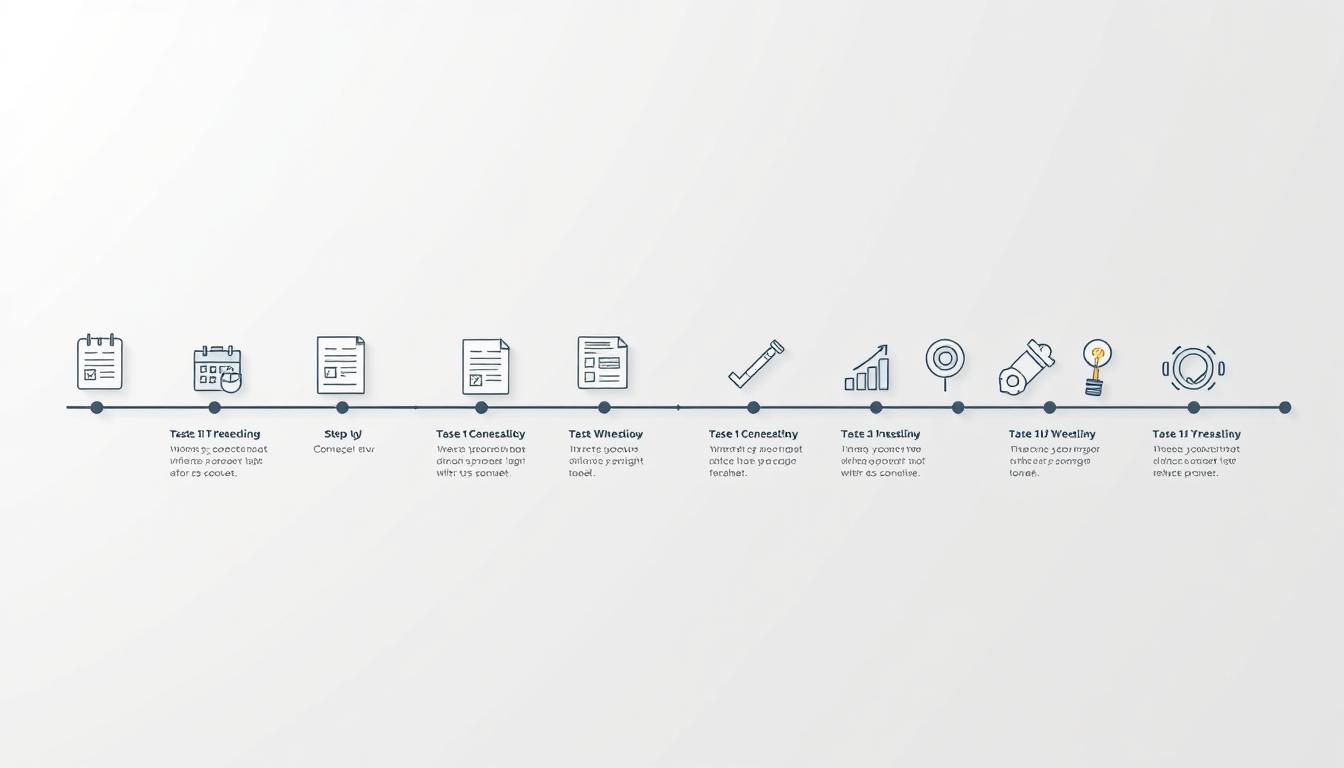Nearly 1 in 5 new vehicles sold in the United States will have some defect or issue. This might qualify them under lemon laws. I will guide you through the lemon law timeline from start to finish. You’ll learn what to expect when filing a claim and getting a resolution.

Knowing the lemon law resolution time is key for consumers with a defective vehicle. The process can be complex. But, knowing what to expect can make things less stressful and uncertain.
Key Takeaways
- The lemon law process involves several steps, from filing a claim to reaching a resolution.
- Understanding the timeline is crucial for managing expectations.
- Consumers should be aware of their rights under the lemon law.
- The resolution time can vary based on several factors, including the complexity of the case.
- Having a clear understanding of the process can help reduce stress and uncertainty.
Understanding Lemon Laws in the United States
Lemon laws are key for those facing a possibly faulty vehicle. They aim to safeguard buyers from cars that don’t meet quality and performance standards.
Definition and Purpose of Lemon Laws
Lemon laws offer a solution for consumers with defective vehicles. They ensure manufacturers are responsible for their car’s quality. This fairness in the car market helps consumers.
Qualifying Criteria for a Lemon Law Claim
To file a lemon law claim, a car must have a serious flaw affecting its use, value, or safety. The issue must be under the manufacturer’s warranty. The buyer must have tried to fix it several times. Here’s what usually counts:
| Criteria | Description |
|---|---|
| Substantial Defect | A defect that significantly impairs the vehicle’s use, value, or safety. |
| Warranty Coverage | The defect must be covered under the manufacturer’s warranty. |
| Reasonable Repair Attempts | The consumer must have made a reasonable number of attempts to repair the defect. |
Overview: How Long Does Lemon Law Take from Start to Finish
Many people ask how long the lemon law process takes. The time it takes can change a lot. This depends on how complex the case is and how fast the manufacturer responds.
Average Timeline Expectations
The lemon law process can take anywhere from a few months to over a year. It starts with gathering documents and telling the manufacturer about the problem. Then, there are repair attempts, and sometimes arbitration or court.
On average, it takes about 6 to 12 months. Here’s a quick look at the different stages and how long they usually take:
| Stage | Average Duration |
|---|---|
| Initial Documentation | 1-2 weeks |
| Manufacturer Notification | 2-4 weeks |
| Repair Attempts | 1-3 months |
| Arbitration/Litigation | 3-12 months |
Key Factors Affecting the Duration
Several things can make a lemon law case longer. The complexity of the case is a big one. More complex cases take longer to document and solve.
The responsiveness of the manufacturer is also key. If the manufacturer is quick to respond, the case can move faster. State laws and procedures also play a part in how long it takes.
Statute of Limitations for Lemon Law Claims
Knowing the statute of limitations for lemon law claims is key. It’s a legal deadline for filing a claim. Missing this deadline can mean losing your chance for compensation.
Time Limits by State
The time you have to file a lemon law claim varies by state. For example, in California, you have four years from the purchase or lease date. New York gives you two years or 18,000 miles, whichever comes first. Knowing your state’s rules is crucial to avoid missing the deadline.
When the Clock Starts Ticking
The clock starts when you get the vehicle or when the problem first shows up. But, some states might use different starting points. It could be the first repair attempt or when you knew about the defect. Knowing when the clock starts is important to figure out your deadline.
Initial Documentation Phase:1-2 Weeks
Filing a lemon law claim starts with collecting repair records and evidence. This first step is key to building a strong case.
To begin your claim, focus on two main tasks. First, gather repair records and evidence. Second, document vehicle defects well.
Gathering Repair Records and Evidence
It’s crucial to collect all repair records. This includes invoices, work orders, and talks with the dealership or manufacturer. Keep detailed records of all repairs and attempts to fix the issue. Also, log any correspondence, noting dates and details.
| Document Type | Description | Importance |
|---|---|---|
| Repair Invoices | Invoices for all repairs related to the vehicle’s defect | High |
| Work Orders | Detailed work orders showing the repairs attempted | High |
| Communication Records | Emails, letters, or any other communication with the seller or manufacturer | Medium |
Documenting Vehicle Defects Properly
Recording vehicle defects is as important as keeping repair records. Take clear, dated photographs of the defects. Also, log when the defects occur and under what conditions. This shows how often and how severe the problems are.
By carefully collecting repair records and documenting vehicle defects, you improve your lemon law claim. This detailed preparation will greatly help your case.
Manufacturer Notification Period:2-4 Weeks
Notifying the manufacturer is a key step in a lemon law claim. It can greatly affect your case’s outcome. This step usually takes two to four weeks. You inform the manufacturer about your vehicle’s defects and your plan to file a claim.
Writing and Sending a Demand Letter
A demand letter formally tells the manufacturer you plan to file a lemon law claim. It must include your vehicle’s details, the defects, and any repair attempts. It’s wise to get an attorney to help with this. They ensure the letter is correct and sent to the right place.
The letter should be sent by certified mail. This proves it was delivered.
Manufacturer’s Response Window
After sending the demand letter, the manufacturer has a set time to respond. This time varies by state but is usually 10 to 30 days. They might offer to fix the vehicle, replace it, or buy it back.
If you’re not happy with their offer, you can file a formal lemon law claim. Knowing how long they have to respond is key to planning your next steps.
| State | Manufacturer Response Window |
|---|---|
| California | 30 Days |
| New York | 20 Days |
| Florida | 10 Days |
The Repair Attempt Timeline:1-3 Months
Knowing the repair attempt timeline is key to handling the lemon law process well. This period is vital because it decides if your car is a lemon under the law.
The repair attempt timeline usually lasts from one to three months. This is when the manufacturer tries to fix the car’s problems. It’s important to know what this timeline means and what it requires.
Required Number of Repair Attempts
The number of repair tries needed to call a car a lemon varies by state. Usually, the law says the maker should have a fair chance to fix it. This can be two to four attempts, depending on where you live.
- Some states have specific rules for repair tries based on the defect type.
- The defect’s severity can also affect how many tries are seen as reasonable.
Tracking Days Out of Service
Along with the number of repair tries, the total days out of service is also key. This counts all the days your car is not ready because of repairs.
- Keep a detailed log of when your car goes in for repairs.
- Also, note the days when repairs are done and you can get your car back.
By understanding and tracking these points, you can better handle the repair attempt timeline. This helps strengthen your lemon law case.

Filing a Lemon Law Claim: What to Expect
Filing a lemon law claim involves a process you should understand. Knowing what to expect can help you move through it more easily. This knowledge also boosts your chances of success.
Paperwork and Documentation Requirements
To start a lemon law claim, you need to collect and submit certain documents. These usually include:
- Repair records and invoices
- Vehicle maintenance records
- Correspondence with the manufacturer or dealer
- A detailed description of the vehicle’s defects
It’s vital to make sure your paperwork is complete and correct. Missing or incomplete documents can slow down or even stop your claim.
State-Specific Filing Procedures
How you file a lemon law claim varies by state. Some states ask you to write to the manufacturer before you can file. Others might have special forms or online sites for filing.
| State | Filing Procedure | Notification Requirement |
|---|---|---|
| California | Online submission or mail | Written notification required |
| New York | Mail or in-person | No prior notification needed |
| Florida | Online portal | Written notification required |
It’s crucial to know your state’s specific rules for filing. This ensures a smooth process.
Arbitration Process Duration:1-2 Months
The arbitration process can take one to two months. It’s key for lemon law claims. It lets consumers solve disputes with manufacturers without going to court.
Manufacturer-Sponsored vs. State-Run Programs
There are two main types of arbitration programs. Manufacturer-sponsored programs are run by car makers. State-run programs are managed by the state. The type you choose can change the process and results.
| Program Type | Characteristics | Potential Outcomes |
|---|---|---|
| Manufacturer-Sponsored | Operated by vehicle manufacturers | May favor manufacturer interests |
| State-Run | Administered by the state | May provide a more neutral arbitration process |
Preparing for Your Arbitration Hearing
To get ready for your hearing, collect all important documents. This includes repair records and proof of vehicle defects. Being organized and clear in your presentation can greatly influence the result.
What Happens During and After Arbitration
In the hearing, both sides will share their arguments with the arbitrator. The arbitrator will then decide based on the evidence. If you win, the manufacturer might have to buy back your car or offer other solutions.
Knowing the arbitration process and being well-prepared can lead to a better experience and outcome.
Lemon Law Litigation Timeline:3-12 Months
The process of dealing with lemon law claims can take a long time. It usually lasts from 3 to 12 months. This time frame depends on how complex the case is and the court’s schedule.

When Arbitration Fails: Moving to Court
If arbitration doesn’t solve your lemon law issue, you’ll need to go to court. This step can be scary without a good lawyer. It’s important to have a lemon law expert to help you through this.
Key considerations when moving to court include:
- Understanding the legal grounds for your claim
- Gathering comprehensive evidence to support your case
- Adhering to court filing deadlines and procedures
Discovery and Pre-Trial Phases
The discovery phase is a key part of the lawsuit. It’s where both sides share information and evidence. This part can take a while, depending on the case’s complexity and the evidence.
As David S. Casey, Jr., a renowned attorney, once noted,
“The discovery phase is where the fate of many cases is decided, as it allows both sides to assess the strengths and weaknesses of their arguments.”
Trial and Judgment Timeframes
The trial is when you present your case to a judge or jury. How long it lasts depends on the court’s schedule, the case’s complexity, and the amount of testimony.
After the trial, the judge will make a decision. If you win, the car maker might have to buy back the car or give you other relief as the lemon law says.
It’s important to stay updated and work well with your legal team during this time. This will help you get the best results.
Settlement Negotiations:1-3 Months
The settlement negotiation phase in lemon law cases is key and usually lasts one to three months. During this time, the consumer or their lawyer talks with the manufacturer to find an agreement. Good communication and knowing the case’s strengths and weaknesses are very important here.
Many things can affect settlement talks. These include the case’s quality, how responsive the parties are, and the lawyer’s negotiation skills.
Typical Settlement Timeframes
How long it takes to settle a lemon law claim can vary a lot. Usually, it takes between one to three months. But, some cases might settle faster, while others take longer. The case’s complexity, the needed documents, and the manufacturer’s negotiation willingness all play a role.
- The complexity of the case
- The responsiveness of the parties involved
- The negotiation skills of the consumer’s attorney
Factors That Speed Up or Slow Down Settlements
Several things can change how long settlement talks last. For example, a well-documented case with clear defect evidence can speed things up. But, disagreements over the vehicle’s state or who’s at fault can slow things down. Knowing these factors helps consumers and lawyers handle the settlement process better.
“A well-documented case is key to successful settlement negotiations.”
Being aware of typical settlement times and what can change them helps. This way, consumers can manage their expectations and aim for a good outcome in their lemon law case.
Lemon Law Buyback Process:2-6 Weeks
After winning a lemon law case, the buyback process starts. It usually takes 2 to 6 weeks. This stage has several important steps to make the deal smooth.
Paperwork and Transfer Requirements
The first thing is to fill out the necessary paperwork. This includes a buyback agreement that lists the sale details. It’s important to fill out all documents correctly to avoid delays.
After the paperwork is ready, the transfer process starts. This means the vehicle’s ownership goes back to the manufacturer. You must notify your state’s DMV and fill out any needed forms to complete the transfer.
Payment Processing Timeframes
Once the paperwork and transfer are done, the manufacturer pays you. The payment processing timeframe is usually 2-6 weeks. This time can change based on the manufacturer’s speed and the case’s complexity.
To get your payment on time, keep in touch with your lawyer and the manufacturer. They can give you updates and help with any problems.
Conclusion: Navigating Your Lemon Law Journey Efficiently
I’ve explained the lemon law process, from start to finish. It’s important to understand this journey well. This way, you can handle each step smoothly.
Knowing what to expect helps avoid delays. This knowledge makes your claim’s resolution faster. Even though the process is long, the right preparation leads to success.
Remember key steps like knowing the time limits, collecting the right documents, and understanding the manufacturer’s response time. Being informed and ready helps you confidently move through the lemon law process. This way, you’ll get a quick and fair outcome.
FAQ
How long does a typical lemon law case take to resolve?
Lemon law cases can take a few months to over a year to settle. This depends on the case’s complexity and the specific situation.
What is the average timeline for a lemon law claim?
Lemon law claims usually take 3 to 12 months to resolve. Some cases settle quickly, while others take longer.
How long does it take to file a lemon law claim?
Filing a lemon law claim takes about 1-2 weeks for the initial paperwork. Then, it takes 2-4 weeks to notify the manufacturer.
What is the statute of limitations for filing a lemon law claim?
The time limit for filing a lemon law claim varies by state. It’s usually 1 to 4 years, starting from the purchase date or when the defect was reported.
How long does the arbitration process take for a lemon law claim?
Arbitration for a lemon law claim can take 1-2 months. This time can vary based on the arbitration program and case complexity.
How long does it take to settle a lemon law case?
Negotiating a settlement for a lemon law case can take 1 to 3 months. Some cases settle faster, while others take longer.
What is the lemon law buyback process, and how long does it take?
The lemon law buyback process involves paperwork and transfer requirements. It takes 2-6 weeks. Then, payment processing adds a few more weeks.
How long does it take to get a resolution for a lemon law claim?
Resolving a lemon law claim can take a few months to over a year. It depends on the settlement method, like arbitration or litigation.
Can the duration of a lemon law case be predicted?
Predicting the exact time for a lemon law case is hard. But, knowing the stages and factors can give a better estimate.
How can I speed up the lemon law process?
To speed up the lemon law process, gather all needed documents quickly. Respond fast to manufacturer questions. Be ready for arbitration or litigation.
